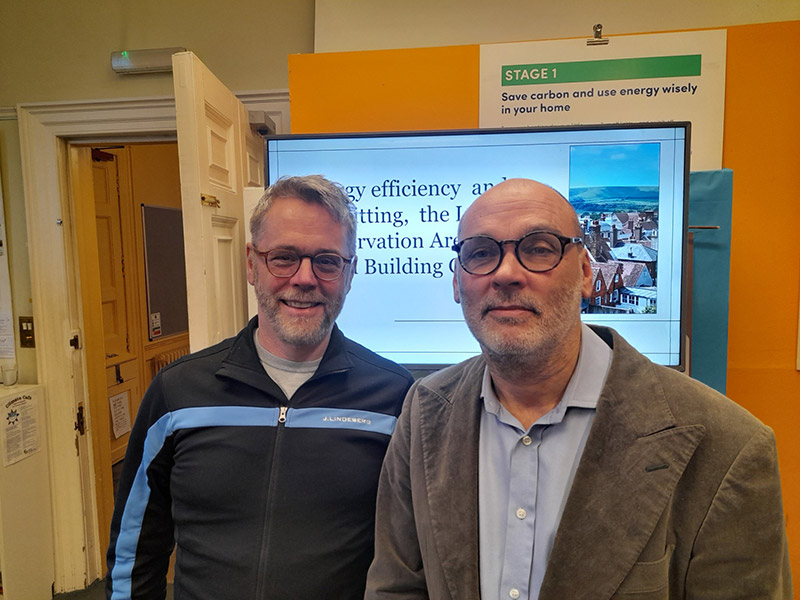
Retrofitting a home in a conservation area
Local architectural academic Suzy Nelson reports on the recent talks by Chris Proctor and Alex Moojen (pictured) at Lewes Climate Hub on what can and can’t be done to homes in the Lewes Conservation Area to reduce draughts and improve energy efficiency.
In October, the South Downs Park National Park Planning Committee adopted a new Conservation Area Appraisal and Management Plan for Lewes. The role of the plan (which can be seen in full here) is to set out guidelines for managing change to buildings and spaces to safeguard the conservation area’s preservation and enhancement.
Being green in a conservation area
An area of confusion for many homeowners (and other property owners) within the Lewes Conservation Area is what steps they can and cannot take to make their properties more energy efficient that may change the property’s appearance.
The good news is that – following consultation feedback – the new Conservation Area Appraisal and Management Plan does give more encouragement to retrofitting buildings within the conservation area. The plan champions a ‘‘whole building approach’’ which considers the building as a system of interconnected materials, functions and users. However, it gives very little detailed guidance on what improvements would be acceptable.
Respecting heritage value
This is partly why, as part of the recent ‘Warm Your Home!’ season at Lewes Climate Hub, we invited Chris Procter of the Architects Climate Action Network to come and talk about some of the shortfalls in the plan and offer guidance on how historic buildings can be retrofitted in a way that is respectful of their heritage value.
In his talk, Chris noted that the new plan identifies buildings that positively contribute to the character of the conservation area, but pointed out that it does not discuss buildings that might benefit from improvement. Other planning authorities provide guidance on opportunities for improvement. For example, Westminster City Council gives detailed advice on where roof extensions would be acceptable.
Chris explained how extensions built to high thermal standards can be wrapped around the historic building fabric to improve the energy efficiency of buildings. He focused in detail on two building elements, external walls and windows. Ideally, external walls should be insulated externally to avoid gaps in the insulation and to reduce the risk of condensation. Whilst it is unlikely to be acceptable for street-facing elevations of listed buildings, it may be appropriate for rear elevations of buildings and for front elevations of non-listed buildings which have a rendered finish. Chris explained how windows can be made more energy efficient by using either slim-line or evacuated glass. He showed examples of replacement double and triple-glazed windows which had slim glazing bars matching those of historic windows.
Getting consent
We were also delighted to welcome Alex Moojen, one of the Conservation Officers for Lewes and Eastbourne Councils, who explained what consents are needed for listed buildings and non-listed buildings in the conservation areas.
Alex mainly focused on windows, because they are the most frequent subject of conservation enquiries. He explained that replacing timber windows in listed buildings would only be acceptable if they were in a poor state of repair or were historically inappropriate replacements. If buildings are listed, consent is required for secondary glazing and careful consideration should be given to its sub-division, opening and fixings. Alex encouraged people to seek advice about any proposed changes to buildings in the conservation area either by emailing him or by booking a 15-minute consultation at the monthly drop-in sessions at Lewes Town Hall.
Watch Chris and Alex’s talks on the Lewes Climate Hub YouTube Channel here.
More information
Chris Procter is the principal author of the Architects Climate Action Network’s Climate Emergency Conservation Area Toolkit. Copies can be downloaded or hard copies ordered from https://www.architectscan.org/conservation-area-toolkit-retrofit-homes.
Dates of Lewes and Eastbourne Conservation drop-in sessions: https://www.lewes-eastbourne.gov.uk/conservation. Email to book a session.
